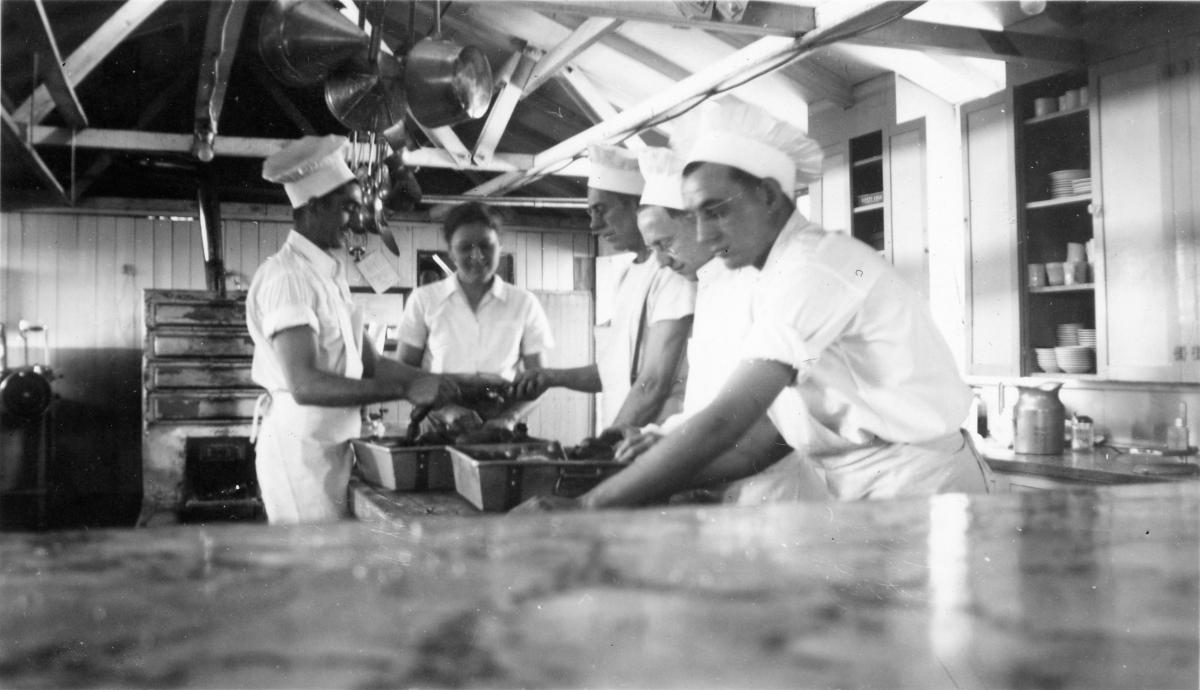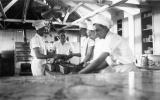CPS Unit Number 064-01
Camp: 64
Unit ID: 1
Operating agency: MCC
Opened: 1 1943
Closed: 7 1946
Workers
Total number of workers who worked in this camp: 362
-
 CPS Camp # 64, Terry MontanaKitchen dutyDigital Image at Mennonite Church USA Archives, North Newton, Kansasca. 1943
CPS Camp # 64, Terry MontanaKitchen dutyDigital Image at Mennonite Church USA Archives, North Newton, Kansasca. 1943
-
 ca. 1943
ca. 1943
CPS Camp No. 64, a Farm Security Administration base camp in a former Civilian Conservation Corps camp near Terry, Montana operated by Mennonite Central Committee, opened in January 1943 and closed in July 1946. The men worked on irrigation systems, built farm buildings and fences, and drilled wells.
Terry, the county seat of Prairie County in southeastern Montana, was located on the Milwaukee Railroad Line. The former CCC camp was built a half mile east of the town and the Yellowstone River ran adjacent to the township.
The COs worked on the Buffalo Rapids, a large irrigation project under construction to improve the Yellowstone River Valley. Varying in width from one to five miles, the project extended from Shirley, twenty miles west of Terry to Glendive, forty miles east of the camp.
Work on the project began in November 1937. WPA men constructed the Glendive pumping station with some help from CCC men. At the same time, they created a thirty-five mile canal to carry the water pumped up from the Yellowstone River.
Directors: Ralph Beechy, Henry Guhr, Clarence Schrag
Dieticians: Gladys Neufeld, Mrs. Clarence Schrag
Nurse-Matrons: Mildred Basinger, Mary E. Hostetler, Ruth Wedel
By early 1946, two hundred and eighty-nine different men from twenty-two states had worked for varying periods of service at the camp. The majority of the men declared affiliation with Mennonite groups when entering CPS. Many were married.
In general the men found the work at Terry to be interesting and varied.
Two agencies cooperated on the Buffalo Rapids irrigation project. While primarily under Farm Security Administration where sixty-five percent of the men were assigned, the remaining thirty-five percent of the camp men worked with the Bureau of Reclamation, which laid the foundation of the irrigation system. In the final stage, the Buffalo Rapids Farm Association built farm buildings, fences, drilled wells and other work necessary to provide habitable farm units.
Men surveyed, leveled land with Caterpillar tractors, built concrete forms, poured and finished concrete. They helped to complete farmsteads in the Buffalo Rapids Farm Association as they built a house, a barn and poultry house on each unit of eighty or one hundred and sixty acres. Through cooperatives, farmers were able to replace land lost during the drought of the 1930s.
The CPS men worked on the water pumping plant, cut native prairie grass, constructed fencing, and built root cellars.
They planted and maintained a twenty acre garden plot in 1944 near the Shirley pumping plant which made irrigation possible. It yielded large amounts of produce.
They also provided emergency farm aid. Normally the labor of CPS men was paid into the camp treasury by the agency receiving the emergency farm aid. Since the Buffalo Rapids Farm Association was a private entity however, MCC faced problems in gaining reimbursement.
In March 1943, sixty campers assisted the Milwaukee Railroad Company to rebuild track that had been washed out by ice floes in the Yellowstone River. One man even transported colleagues across the river to work after the highway bridge was destroyed in the same flood. He kept two boats in repair and rebuilt docks as well.
In April 1943, men helped stop a prairie fire which destroyed thousands of acres of grassland and threatened the camp. In August they helped fight a timber fire thirty miles south of the camp.
Before the camp opened, organizers invited community and church leaders to a meeting to learn the nature of a CPS camp community of conscientious objectors.
When the men arrived, they were welcomed into local churches and into community members’ homes. The CPS men not only participated in religious services at the camp, but also gave programs in neighboring churches and in the two Mennonite churches in Bloomfield.
During a teacher shortage, one CPS man, Glenn Graber, a graduate of Bluffton College, taught science at Terry High School in the spring of 1943.
The community also welcomed the wives of married assignees. They found employment in the hotel, café, dental office, dry goods store, hospital, and the school, where one woman taught. Some wives performed house work. The women contributed to both the community and the camp. As an example, they sewed curtains for the social room and gave a Sunday evening program on “Christian Living as CO Girls”.
Aganetha Fast, a former missionary to China, visited women living near MCC camps in the western states. MCC, sensitive to reports about “breaches in conduct” such as unmarried men slipping away from base camps overnight to visit their sweethearts, sent Fast to address camp morality and assist “in whatever way she could”. Twenty years older than the men and women, she had little influence on the camp followers, but did establish women’s organizations to strengthen relationships among women living near the camps. The Terry group called themselves Builderettes. (Goossen p. 55).
In 1946, twenty-seven CPS wives began circulating a round-robin letter as a testament to the community they developed while renting rooms or sharing houses near the camp. “One of the wives made a list of all the CPS women who lived in Terry. . .wrote a letter, tucked it into an envelope with an address list, and mailed it to the women whose name appeared next on the list” (Goossen p. 122). Survivors today look forward each year to those letters.
For recreation, the men fished and hunted, ice skated on the pond between camp buildings, made hooked rugs and crafts from leather, and enjoyed woodworking. They also collected agates along the banks of the Yellowstone, selling many to local jewelry stores for seventy-five cents per pound. Some men learned to cut, polish, and make brooches and other articles of jewelry.
Terry hosted a Farm and Community school during the winter of 1944-45. The educational program brought educators and church leaders to the camp for study of agriculture, applied courses in shop work and the rural community. The leader, Dan Neufeld, viewed this program as an alternative to college for those who planned to farm and desired to contribute to community life. In one component, men had the opportunity to develop a “personal philosophy of Christian community living”.
In the summer of 1944, John Thut conducted a ten-day music institute at the camp.
In 1944 the men produced an illustrated book much like a college yearbook, called This is Our Story. They also published a camp paper Yellowstone Builder from April 1943 to May-June 1946.
After the war ended, camp morale declined and dissatisfaction expressed over superficial reports portraying “only the righteousness of our living” were editorialized in the Yellowstone Builder (March, 1946). Government agencies noted changes in work attitude and camp leaders experienced difficulty maintaining standards of conduct.
For more information on this camp, see Melvin Gingerich, Service for Peace: A History of Mennonite Civilian Public Service. Akron, PA: Mennonite Central Committee printed by Herald Press, Scottdale, PA 1949, pp. 169-176.
For more information on women COs see Rachel Waltner Goossen, Women Against the Good War: Conscientious Objection and Gender on the American Home Front, 1941-47. Chapel Hill, NC: The University of North Carolina Press, 1997.
For general information on CPS camps see Albert N. Keim, The CPS Story: An Illustrated History of Civilian Public Service. Intercourse, PA: Good Books 1990.
For an in depth history of conscientious objection in the United States, see Mulford Q. Sibley and Philip E. Jacob, Conscription of Conscience: The American State and the Conscientious Objector, 1940-1947. Ithaca, NY: Cornell University Press, 1952.
Swarthmore College Peace Collection, Camps publication database.